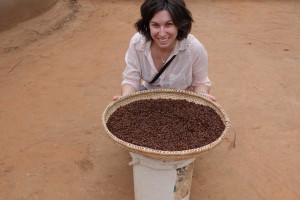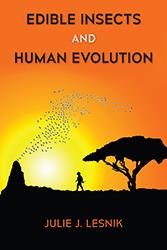 Interview with Julie Lesnik, authoress of “Edible insects and human evolution”
Interview with Julie Lesnik, authoress of “Edible insects and human evolution”
Hi Julie, tell us a little about yourself and your interest in edible insects
I am a faculty member in the Department of Anthropology at Wayne State University in Detroit, Michigan, USA. I totally stumbled into studying edible insects! While working on my PhD I wanted to find a project that let me study the intersection of tools, nutrition, and brain size expansion over the course of human evolution. Most commonly people interested in these kinds of topics study hunting and meat eating, however, I was most interested in older, smaller-bodied hominins who are not thought of as hunters yet their brains reach sizes that are 20% greater than that of chimapanzees. They must have been doing something different with their diets in order to support the nutritional demands of this brain size increase, and I ultimately found myself studying how termites could have been a critical food resource at this time.
How and when did you have the idea to write a book?
In April of 2013 I was at a conference and a good friend and mentor of mine suggested that my research would make a good book. I was in a place in my career where research funds were difficult to come by yet it was very important that I maintained an active research agenda if I was to have a chance at getting a faculty position. So I pitched the book to publishers that were present at the conference, and my advanced contract with the University Press of Florida came shortly thereafter. I carry a bit of pride that all this happened before the UN FAO statement came out just a month later, but am also ever grateful for it becasue it helped me frame the content of the book in a much more meaningful way. Having the book contract was definitely helpful in getting my current job in 2014, but with the demands of said job, I decided to push off its publication about two years past what was originally planned.
Can you briefly explain the content?
My book walks through how we can reconstruct behavior in the past when working with such scant evidence. In many ways, insect eating is invisible in the archaeological record, so I create models of how it may have looked based on how people across the world forage for insects and how our primate cousins eat insects. For instance, chimpanzees are our closest living relative, but the last common ancestor that we share with them was neither human nor chimpanzee. But we can guess at some of the behaviors of this ancient ancestor based on things we share with chimpanzees, and using tools to forage for termites is one of those behaviors. With that as a starting point, I am able to discuss the ways insect foraging became more sophisticated over time, ultimately reaching the topic of insect farming today.
Do you think that human entomophagy will soon be successful in the western world?
I think there will be a steady increase in its acceptance as the years go on, but that it will take a generational turnover before it is widespread. It will take an entire generation of adults raising their kids with the idea that insects can be food and then it will be the kids‘ generation who make it mainstream.
What’s the best strategy to help the modern consumers to overcome the “yuk factor”?
Learning the psychology of disgust really helped me. Disgust is something that gets programmed into our brains at an early age. It takes parents telling their kids not to play in trash cans and toilets for those kids to grow up with an aversion to the idea of touching those things. Unfortunately in western culture, we indoctrinate our kids into finding bugs disgusting while other cultures have a much more nuanced appreciation for insects, identifying which are harmful and which ones are helpful. So accepting that the disgust was real and understanding why it was there helped me to know that it was something that could be overcome.





